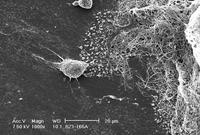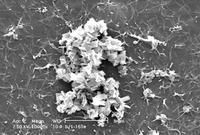Editor: Diggers asked for pictures; here they are! Return the favor: try to visit more than this page this time ;) You should find interesting stuff in the Related stories (floating to the right of the text) and the Popular news sections (right sidebar). Enjoy!

Bone cells appear as a clump at left, carbon nanotubes appear on the right.
Researchers at the University of California, Riverside have published findings that show, for the first time, that bone cells can grow and proliferate on a scaffold of carbon nanotubes.
The paper, titled Bone Cell Proliferation on Carbon Nanotubes, appears in the March 8 edition of Nano Letters, a journal of the American Chemical Society. Lead author, Laura Zanello, is an assistant professor of biochemistry at UCR and was joined by UCR colleagues, graduate students Bin Zhao and Hui Hu, and Robert C. Haddon, distinguished professor of chemistry and of chemical and environmental engineering.
Zanello's paper builds on previous research by Haddon which showed that carbon nanotubes could be chemically compatible with bone cells.
Zanello's experiment put Haddon's findings to the test and found that the nanotubes, 100,000 times finer than a human hair, are an excellent scaffold for bone cells to grow on.
"In the past scientists have been plagued by toxicity issues when combining carbon nanotubes with living cells," Zanello said. "So we have been looking for the most pure nanotubes we could get to reduce the presence of heavy metals that are frequently introduced in the manufacturing process."

Bone crystal growth on carbon nanotube substrate.
She credited Haddon's graduate student Zhao, now a postgraduate researcher at the Oak Ridge National Laboratory, with manufacturing highly pure nanotubes for her to work with.
Some of the carbon nanotubes were chemically treated and others were not, then they were combined with rat bone cells to determine which combination or combinations worked best. Non-treated and electrically-neutral nanotubes emerged as the best scaffolds for bone growth.
Because carbon nanotubes are not biodegradable, they behave like an inert matrix on which cells can proliferate and deposit new living material, which becomes functional, normal bone, according to the paper. They therefore hold promise in the treatment of bone defects in humans associated with the removal of tumors, trauma, and abnormal bone development and in dental implants, Zanello added.
More research is needed to determine how the body will interact with carbon nanotubes, specifically in its immune response, the paper states.
"We hope to look at the atomic interactions between living matter and synthetic scaffolds so we can come up with material that can interact at the nanolevel with living cells," Zanello said
Source : University of California - Riverside
 Print Article
Print Article Mail to a Friend
Mail to a Friend
